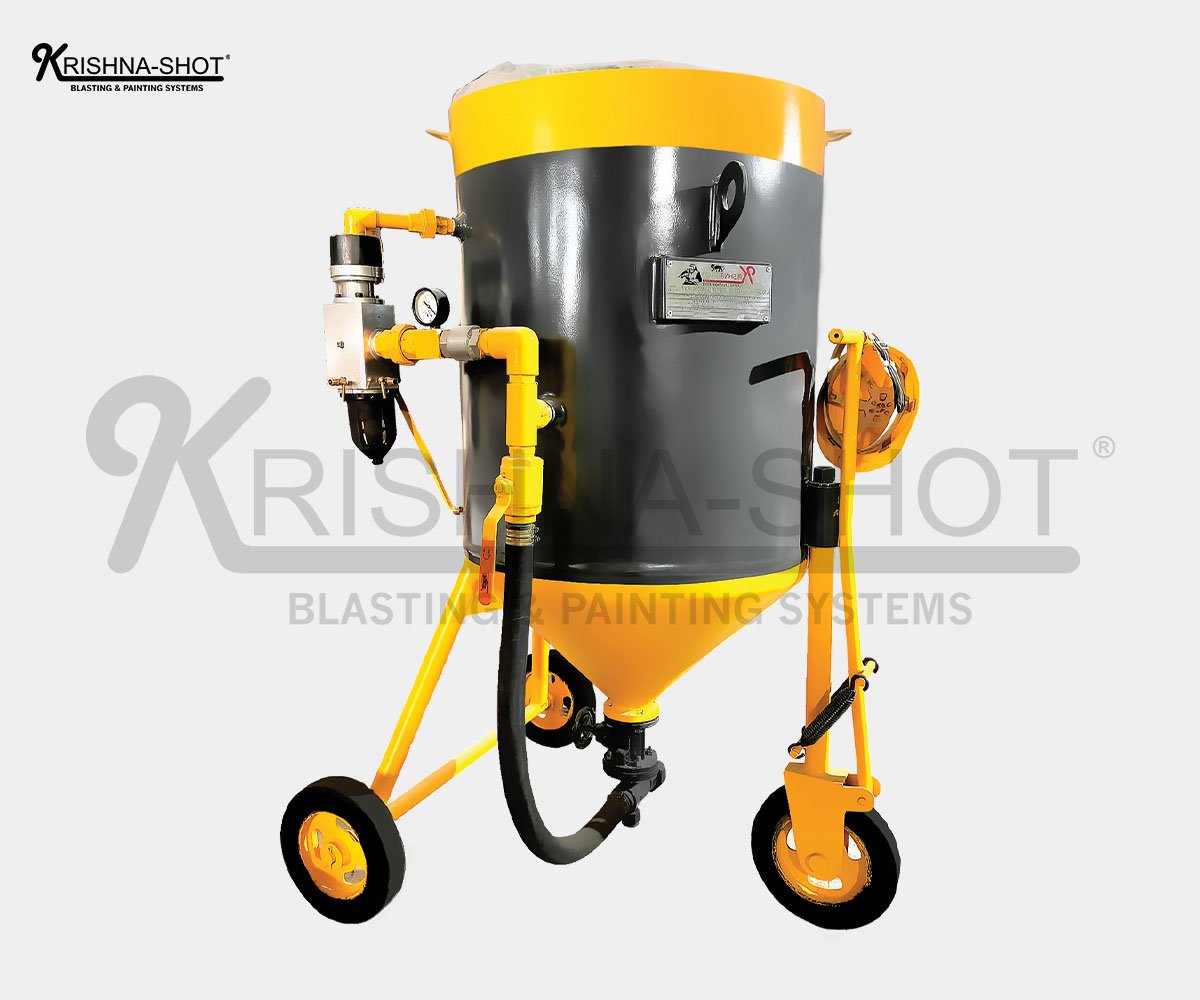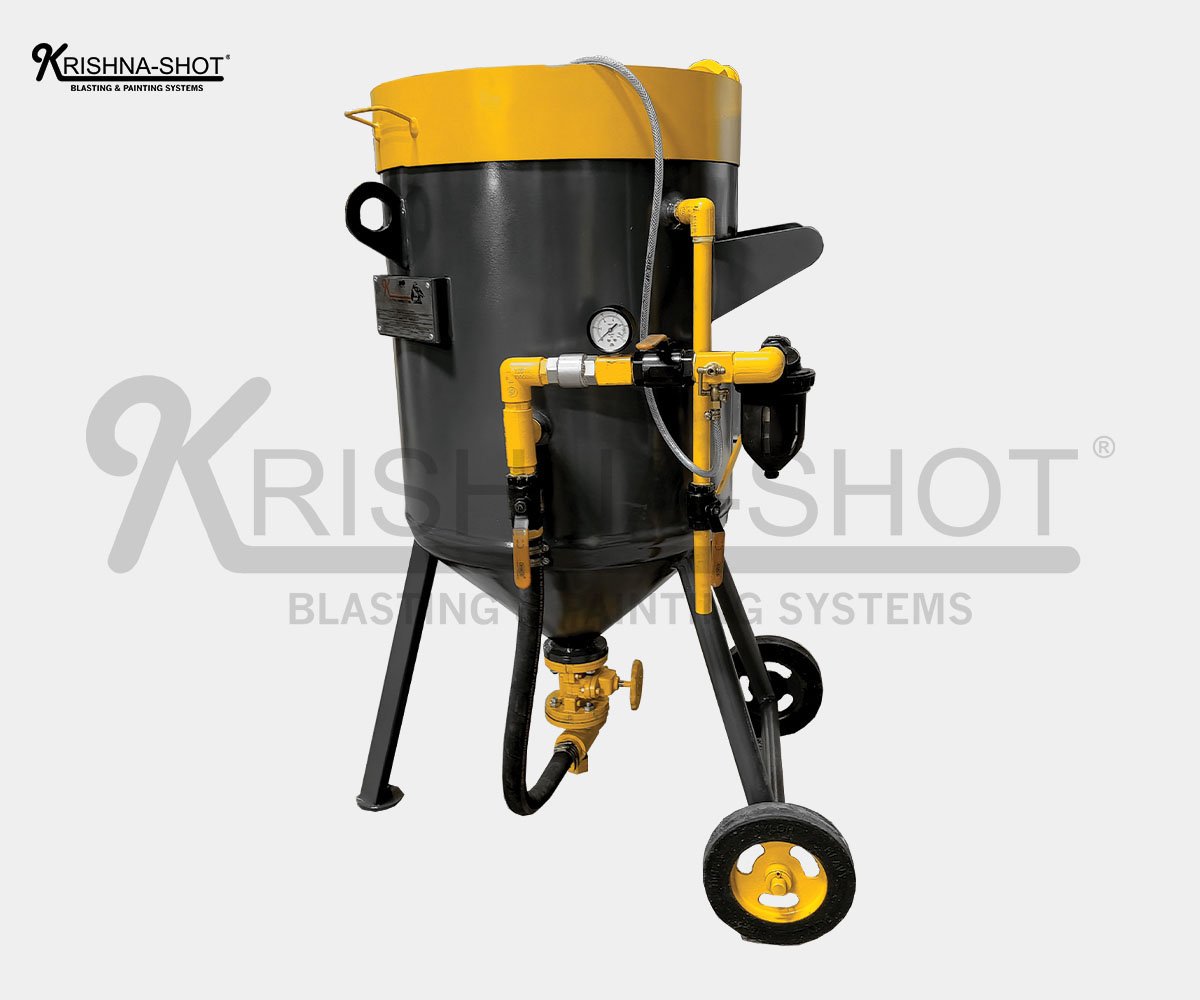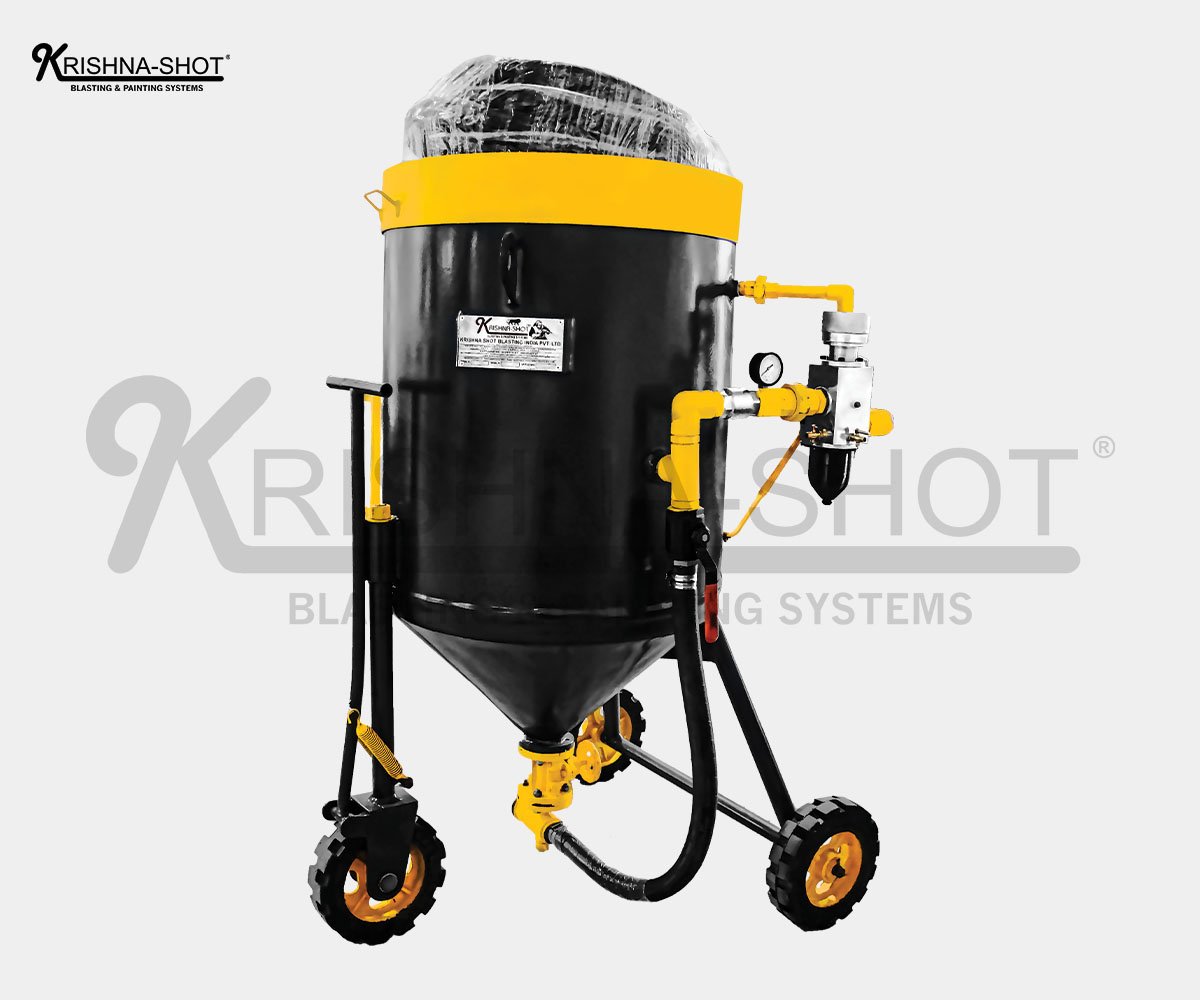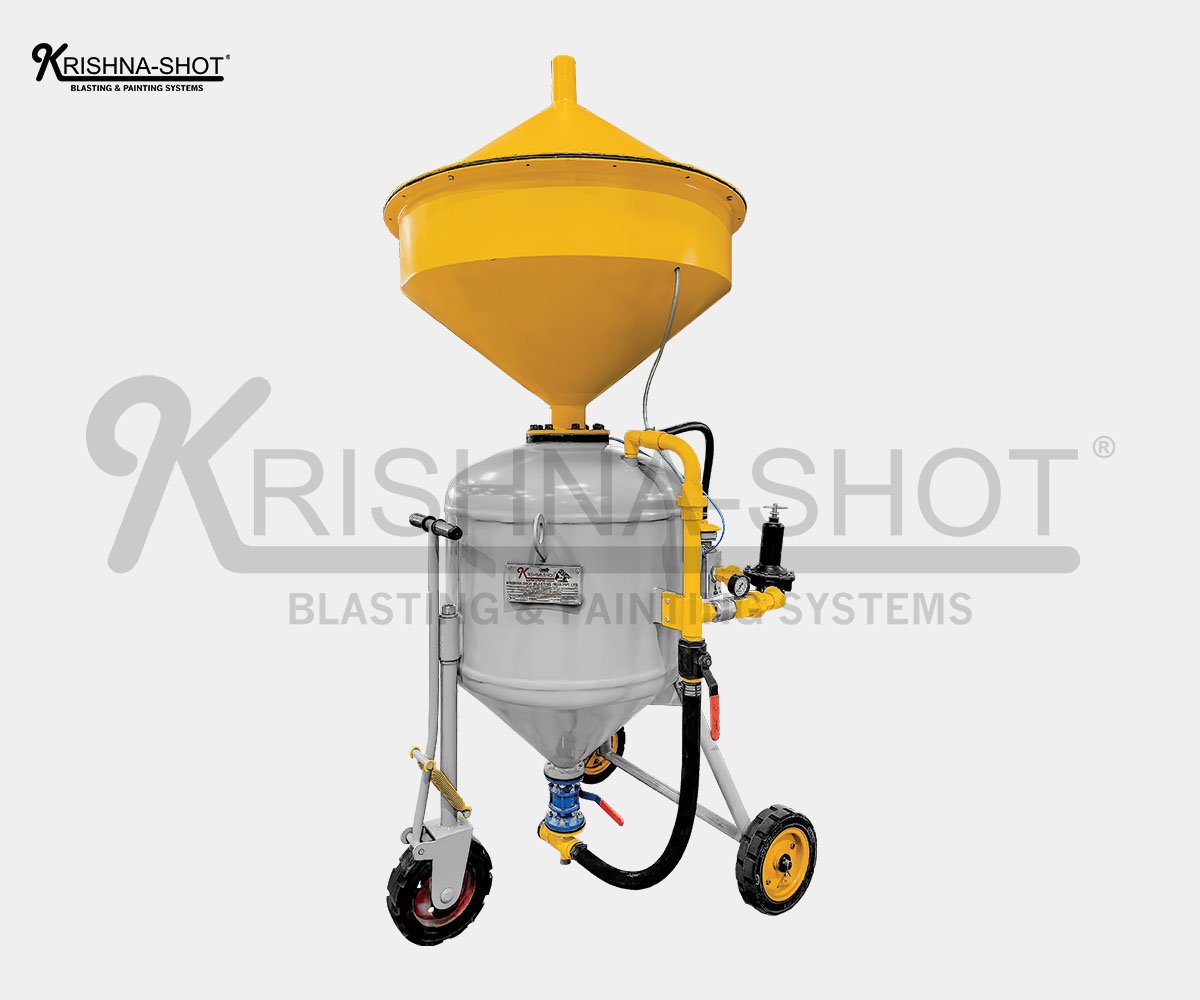Sand Blasting Machine
Manufacturer & Supplier Details
- Brand Name: KRISHNA-SHOT®
- Company Name: Krishna Shot Blasting India Pvt. Ltd.
- Experience: 20+ Years in Surface Finishing Solutions
- Verification: Trustseal Verified (Leading Manufacturer & Supplier)
- Delivery Time: Typically 30 Days
- Address: Plot No. 30, Sarita Vihar Nagar, Near Tanawada, Main Salawas Rd, Jodhpur, Rajasthan 342005
- Specialization: Shot Blasting Machines, Blast Rooms, and Paint Booth Systems
- Customer Support: Dedicated after-sales service and technical support
- Certifications: ISO-certified products
Description
Sand Blasting Machine
A Powerful Blasting Machine for Surface Cleaning and Preparation
sand blasting machine is a highly effective industrial tool used for cleaning, surface preparation, and finishing. By propelling abrasive media, such as sand, aluminum oxide, or steel grit, at high speeds, these machines are capable of removing rust, paint, contaminants, and old coatings from various surfaces. Sandblasting is a crucial process in a wide range of industries, including automotive, construction, shipbuilding, and metal fabrication, for tasks that require effective and efficient cleaning and surface preparation.
What is a Sand Blasting Machine?
A sand blasting machine uses compressed air to propel abrasive materials through a nozzle onto a surface, creating a high-impact force that cleans, smooths, or etches the surface. The abrasive media used in sandblasting varies depending on the specific requirements of the task. While sand is the traditional abrasive, many other materials, such as steel grit, glass beads, or garnet, can be used depending on the type of work and surface.
Sand blasting machines are commonly found in both industrial and commercial applications. They are equipped with various features and mechanisms that enhance their efficiency, precision, and versatility.
Key Components of a Sand Blasting Machine
- Compressor
The compressor provides the high-pressure air needed to propel the abrasive material. The capacity of the compressor determines the speed and effectiveness of the sandblasting process. More powerful compressors can handle larger surfaces and tougher cleaning tasks. - Abrasive Media
The abrasive media is the material used to clean or prepare surfaces. Common abrasive materials include:- Sand: Traditionally used in sandblasting, though less common today due to health concerns related to silica dust.
- Aluminum Oxide: A highly durable and sharp abrasive, ideal for metal surfaces.
- Steel Grit: Used for heavy-duty applications like rust removal from steel.
- Glass Beads: Ideal for cleaning and polishing softer surfaces.
- Garnet: A natural abrasive that provides excellent performance for many surfaces.
- Blast Hose and Nozzle
The blast hose carries the compressed air and abrasive media from the machine to the nozzle, which directs the media onto the surface being cleaned. The nozzle controls the size and force of the abrasive stream, allowing operators to adjust for different tasks. - Tank
The tank stores the abrasive material before it is used in the blasting process. Depending on the size of the machine, the tank can hold a large volume of media, allowing operators to work for extended periods before needing to refill. - Control Valve
The control valve regulates the flow of the abrasive material and air. It allows the operator to adjust the intensity of the sandblasting process, which is crucial when dealing with delicate materials or surfaces that require a lighter touch.
Types of Sand Blasting Machines
- Siphon Feed Sand Blasting Machine
In a siphon feed system, compressed air creates a vacuum that draws the abrasive material from the storage tank and into the blast hose. This type of machine is often more affordable and suitable for lighter, smaller tasks. It tends to be slower and less efficient compared to pressure-feed models but is still effective for general surface cleaning. - Pressure Feed Sand Blasting Machine
Pressure feed sandblasting machines use pressurized air to push the abrasive media from the tank to the nozzle. This method allows for higher speeds and greater efficiency, making it ideal for larger-scale tasks or more demanding applications. Pressure-feed sandblasters are often used in industrial settings where higher productivity and faster cleaning are required. - Wet Sand Blasting Machine
A wet sand blasting machine combines water with abrasive media, creating a slurry that is used for cleaning surfaces. The water helps reduce dust, which is beneficial for creating a safer work environment, especially in enclosed spaces. Wet blasting is also more gentle on surfaces compared to dry sandblasting, making it ideal for delicate materials.
Applications of Sand Blasting Machines
- Surface Cleaning and Rust Removal
Sandblasting is one of the most effective methods for cleaning rust, paint, and other contaminants from metal surfaces. Whether you’re restoring old machinery or preparing a metal surface for coating, sandblasting can provide a thorough and even finish. It is commonly used in industries such as automotive, shipbuilding, and construction. - Paint Stripping and Coating Removal
Sandblasting is a fast and efficient way to strip paint from surfaces without damaging the underlying material. This makes it an essential process in industries like construction, automotive refinishing, and restoration. It’s also widely used for removing coatings or old sealants from concrete or steel surfaces. - Surface Preparation for Coating or Welding
Before applying new coatings, such as paint, powder coating, or galvanization, it’s crucial to prepare the surface by cleaning it and ensuring optimal adhesion. Sandblasting provides a smooth, clean surface that ensures the new coating adheres properly and lasts longer. In metalworking, sandblasting is often used to prepare surfaces for welding. - Etching and Polishing
Sandblasting is also used for decorative purposes, such as etching designs onto glass, stone, or metal surfaces. It’s a popular method in the creation of personalized glassware, plaques, and signage. Additionally, it can be used for polishing certain materials, such as stainless steel, by providing a uniform finish. - Concrete and Masonry Cleaning
Sandblasting machines are used in construction to clean concrete surfaces, remove old coatings, or prepare concrete for refinishing. This is also a common method for cleaning brickwork or stone surfaces. Sandblasting helps restore the appearance of old masonry and removes years of grime and wear. - Shipbuilding and Maintenance
Sandblasting is a critical part of shipbuilding and maintenance, as it helps remove rust, old paint, and contaminants from the metal surfaces of ships. The machine is used to clean the hull, decks, and other metal parts, preparing them for re-coating and protecting the vessel from further corrosion.
Advantages of Using a Sand Blasting Machine
- High Efficiency
Sandblasting is one of the fastest ways to clean large or heavily contaminated surfaces. The abrasive material strikes the surface with great force, removing rust, paint, and other contaminants quickly and effectively. It is particularly valuable when working on large projects where speed and efficiency are crucial. - Versatility
Sandblasting can be used on a wide variety of materials, including metals, concrete, wood, glass, and stone. The ability to choose from different abrasive media ensures that sandblasting can be tailored to suit specific tasks, whether you’re cleaning, etching, or preparing surfaces for coatings. - Surface Quality
Sandblasting creates a high-quality finish, removing all impurities from the surface and ensuring it is clean and ready for further processing, whether it’s coating, painting, or welding. The ability to adjust the blasting pressure ensures that surfaces are prepared properly, without causing damage. - Cost-Effective
Sandblasting is an efficient method that reduces labor costs and downtime. By using abrasive materials to speed up cleaning and surface preparation, this method can save both time and money compared to manual cleaning methods. - Dust Control
Modern sandblasting machines are equipped with dust collection systems to minimize airborne particles. This ensures a safer working environment and helps comply with safety regulations, especially in confined spaces.
Safety Considerations for Sand Blasting
Sandblasting involves high-pressure air and abrasive materials, so it is essential to follow safety guidelines to protect operators and those around them:
- Wear Personal Protective Equipment (PPE): Operators should wear goggles, gloves, respirators, ear protection, and protective clothing to safeguard against flying debris and inhalation of dust.
- Proper Ventilation: Sandblasting creates a lot of dust, so adequate ventilation is crucial. Consider using a dust collection system to minimize airborne particles and improve air quality.
- Inspection and Maintenance: Regularly inspect the sandblasting machine to ensure it is functioning correctly. Check the hoses, nozzles, and compressor to avoid accidents or malfunctions during operation.
Sand Blasting Machine Point of View
sand blasting machine is a powerful and versatile tool for cleaning, surface preparation, and finishing. Whether you’re removing rust, stripping paint, etching designs, or preparing surfaces for coating, sandblasting offers fast, effective results. With different types of machines available, from siphon feed to pressure feed models, and a variety of abrasive media to choose from, sandblasting can be tailored to meet the needs of any job. The efficiency, speed, and quality of sandblasting make it an essential process in industries ranging from automotive to construction, shipbuilding, and more. With proper safety precautions and maintenance, a sandblasting machine can significantly enhance productivity while ensuring high-quality surface finishes.












